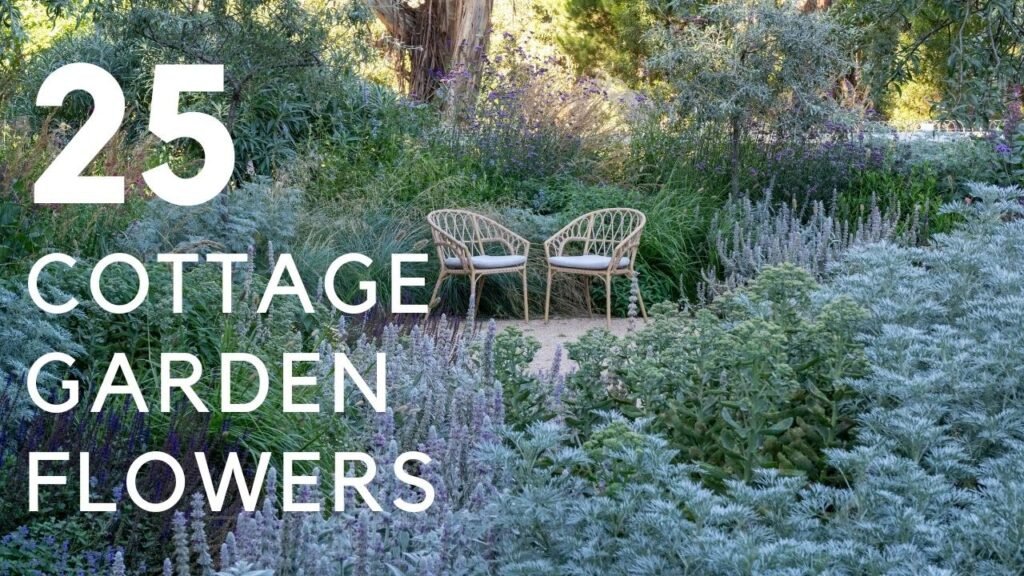Introduction to Cottage Garden Plants
The best cottage garden plants are pretty, flower for a long time, some are fragrant, they’re wildlife friendly, and above all, they grow well in your climate and soil. It’s Alexandra from The Middle-Sized Garden website and blog, and I’ve picked out 25 of the best cottage garden plants from gardens I’ve visited.
25 Best Cottage Garden Flowers
What Makes a Cottage Garden?
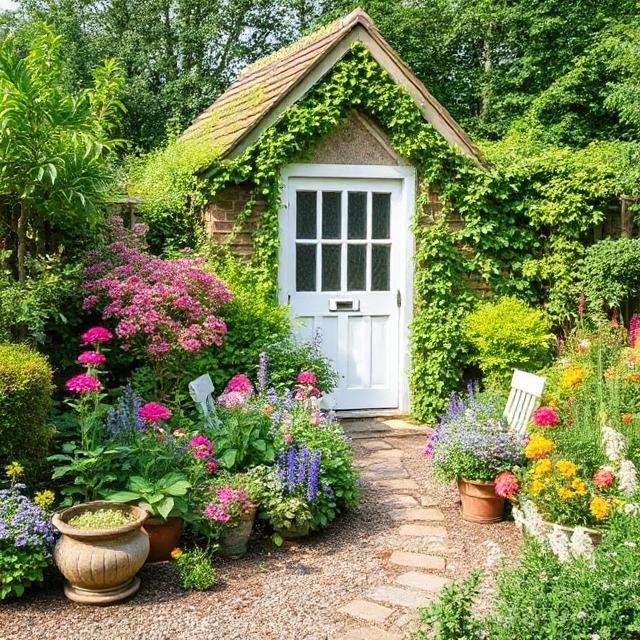
You can colour-scheme a cottage garden, like Tim Pilgrim has in this contemporary cottage garden, or you can make it a riot of colour – a patchwork of flowers. Either is fine. There are no real rules in cottage gardens. So, what is a cottage garden? The idea was that cottages would grow plants that they could grow cheaply and easily. So they mig,, ht for insta,n,ce have taken cuttings from frins, or got seeds from a nearby garden.
The plants were mainly not just pretty but functional—you might make soaps out of them, use cottage garden plants medicinally, eat a wide range of them, and, of course, flowers just to cheer one up and provide food for pollinators.
Native vs. Non-Native Plants
Native plants are good if you’re thinking of a cottage garden because native plants will always give your wildlife the best chance. How, ever in many parts of the w,orld you don’t have to stick to native plants, because we have unexpected weather patterns, and we may have an unexpectedly early warm spring, or perhaps a very late warm autumn. And so the pollinators will be out there – our native plants may have stopped flowering, and non-native plants (provided they’re not invasive) are a beneficial source of nectar and pollen. So it’s not a one-size-fits-all situation, but certainly start with native plants for a cottage garden.
Top Cottage Garden Flowers
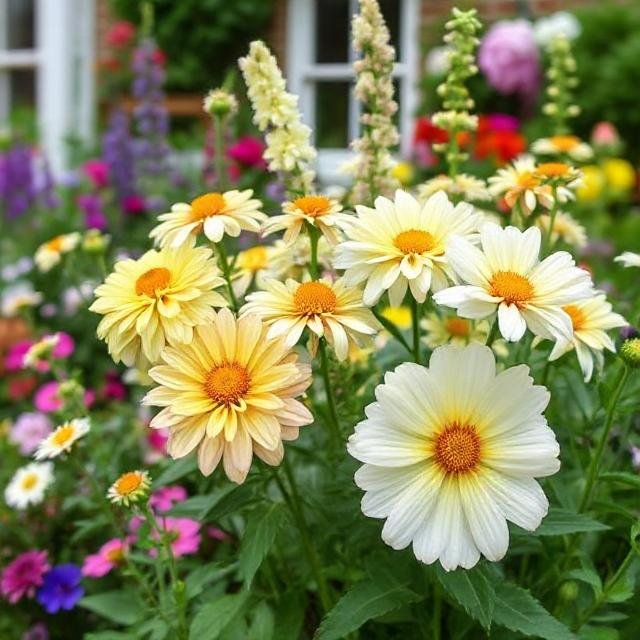
1. Asters (Symphyotrichum)
So I’m going to start with asterisks. Now renamed in some cases to Symphyotrichum, you can get asters or plants that look like asters worldwide. They are native to the Prairies of North America and Canada. Some asters are native to Europe and Asia. So you can find one wherever you are. And they come in beautiful pinks and blues and whites. They’re great for late-season colour and interest.
2. Honeysuckle
Perhaps the most classic cottage garden climber has to be the honeysuckle. And of course, it’s got a beautiful fragrance and is very life-friendly. Violets do come with a bit of a warning. Once again, some honeysuckles are native to North America, there are honeysuckles native to Asia, and there are ones native to Northern Europe. Busomeme othem- thehIanaexample- cabe seeniin Northth America. So you have to check what kind of honeysuckle you’re planting before planting it. The other thing with honeysuckles is that some of them are very vigorous and will grow and grow and grow. So, unless you want to spend a lot of time clipping them back and back, check the final size
3. Poppies
One of the classic cottage garden flowers is poppies. Now, annual poppies grow from seed, and the seed can survive frigid winters. But they’ll need the weather to warm up before it germinates. An annual is a plant that grows from seed and flowers, and dies in one year. And of course, the common poppy or Papaver rhoeas is one of those. Now it’s typically found where you’ve had the soil disturbed. For example, when I dug up my border after 15 years of leaving it pretty much as no-dig, I got loads of poppies the following summer.
Of course, that’s why it stands for the First World War. Poppies appeared in the fields after the First World War because tanks and trenches had been dug up. Poppies are really wildlife friendly—I’ve often found two bees in one of my poppies—so they’re an excellent choice. They come in scarlet and some pretty purples and lilacs, so it’s worth looking at the different varieties.
4. Catmint (Nepeta)
Another cottage garden classic is catmint or nepeta, and the only reason not to have catmint is that it could attract cats into your garden. However,,, it’s drought resistant, deer resistant,, slug and snail resistant, it grows easily, flowers for a long time – reallybably the easiest plant in the world to grow. And it comes in white, lilac, nd blue. People often recommend growing catmint or nepeta, rather than lavender, because it has a similar effect and is a much more resilient plant. Although it must be said that lavender is a pretty,easy-to-grow plant, it just doesn’t like getting its feet wet.
5. Globe Thistle (Echinops)
Another easy grow, drought-resistant, slug-resistant, deer-resistant plant is the globe thistle or echinops. And I’ve got two clumps in my garden, and quite frankly, they are indestructible, and the bees love them, and they give a sort of sculptural interest, and a lovely grey foliage to the border. Once established, globe thistles need hardly any care. The birds will eat the seed heads in the winter,, it’ll all gradually collapse, and then you can clear it awa,y, and new foliagwilll pop up from the base in the spring.
6. Hardy Geraniums
Another plant that no cottage garden will be without is hardy geranium. Now people mustn’t get confused between hardy geraniums and pelargoniums. Pelargoniums are usually labelledd geraniums in gardencentress, but they’re very tender;; they won’t last a winter outside unless you’re in a very hot climate. And they’re usually in pots – they’re very Mediterranean. But hardy geranium can tolerate some icy areas. And there is a vast number of them. There are about 500 different varieties.
And some of them, like my Anne Thompson or Ann Folkar of spread and their flow of roam agh yoorder. And other ones are a lovely low-growing ground cover, and there are even hardy geraniums for dry shade. So what more can you ask? Hardy geraniums flower for months, and the only care they ever need is to be chopped back once a year – and that’s it. They’ll grow another set of flowers afterwards.
Higher Maintenance Cottage Garden Plants
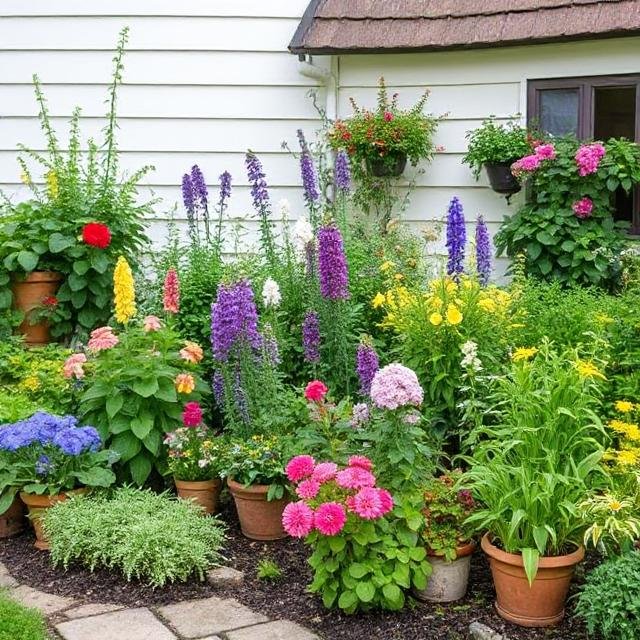
So far, all the plants I’ve mentioned have been straightforward to care for and low maintenance, but some cottage garden plants are pretty and fragrant and need a lot of work.
7. Sweet Peas
For example, you will see people say that sweet peas are easy to grow. Looking after sweet peas isn’t tricky, but you have to attend to them every day. They can get eaten by slugs, and you must constantly deadhead them to keep the flowers going. You’ll need to train them up and support them. I’ve got very few photographs of sweet peas, and that’s because so few of the gardens I visited have them in them, which I think says something.
8. Lupins
The lupin is another plant that needs a little extra care, although it does produce some wonderful, gorgeous spikes of colour. Some lupins are hardy and will live over winter, but most are treated as annuals. And like all annuals, you’ll need to plant them in spring, you’ll need to protect them from slugs and snails, you’ll possibly need to support them, and then you’ll need to deadhead them and clear them away when they’re over.
9. Delphiniums
Both lupins and those other gorgeous spikes of cottage garden flowers – delphiniums – are a little more complex work. They’re sort of, but don’t think they’ll be low maintenance.
10. Tulips
And in terms of bulbs, I would say tulips are more maintenance-intensive than others, partly because tulips don’t come back year after year, as do other bulbs. When I interviewed Neil Miller of Hever Castle about tulips, he said that you get your best flowers from tulips the year after you plant them, and even if they do come back, they won’t be as good.
If you look at my garden, you will see many different kinds of tulips dotted in ones and twos around the garden. And that’s because I’ve chosen a lovely group of tulips, I’ve planted them in a clump, they’ve come up, they’ve looked gorgeous, and the following year one of those has come back. So I’ve planted another clump of tulips a bit nearby. So you can see the remains of lots of clumps of tulips over the years. And I think it looks pretty and cottage gardeny, but it’s not the effect I was going for.
Best Cottage Garden Bulbs
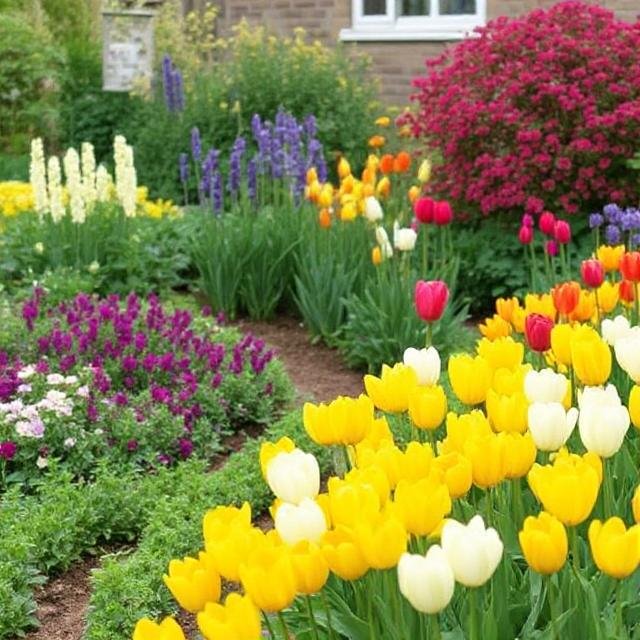
11. Daffodils
So, what are the best cottage garden bulbs? Well, it has to be said that daffodils are so easy. There are thousands of varieties, one near you, they’re very cold hardy, and of course, they provide nectar and pollen in the early months when quite a lot of flowers aren’t up. A lot of the daffodils spread. You can grow daffodils in the lawn for a charming cottage garden effect. Remember that you can’t mow the lawn until 6 weeks after the flowers have died. I find it fine, because you mow the lawn six weeks later, and then the lawn’s fine, but I’m not a lawn perfectionist.
12. Alliums
Alliums have these lovely pom-pom blooms, which are sculptural and easy to grow. And once again, quite a few of them self-seed and spread. I think I bought 15 allium purple sensations about 15 years ago, nd added a hundred in my garden one year ago. So it’s almost a question of having to dig them up and throw them away if they spread too much. Of course, that is a problem with plants that spread very easily. You say, well, will I be overruled? Overall, I think it’s easier to pull plants out to plant them. And it’s certainly cheaper.
So it’s just a question of keeping an eye on it. And deer, rabbits, squirrels and voles don’t like the taste of allium – it’s part of the onion family. So, taking that almost no plant can be completely guaranteed to be deer resistant, it’s probably a good one if you want a cottage garden and have a deer problem.
13. Alstroemerias
Alstroemerias are another beautiful flower. And although they used to be mainly grown for the florists industry, they’re grown quite a lot in gardens. I’ve got a video on how to grow alstroemerias with alstroemeria grower Ben Cross, which I’ll describe below. But they are very easy to grow. The only thing you have to remember about alstroemerias is that you can’t cut them. You have to pull them like rhubarb – you pull the stem out. If you cut them, that t fects how they will go on to flower later.
Best Cottage Garden Shrubs
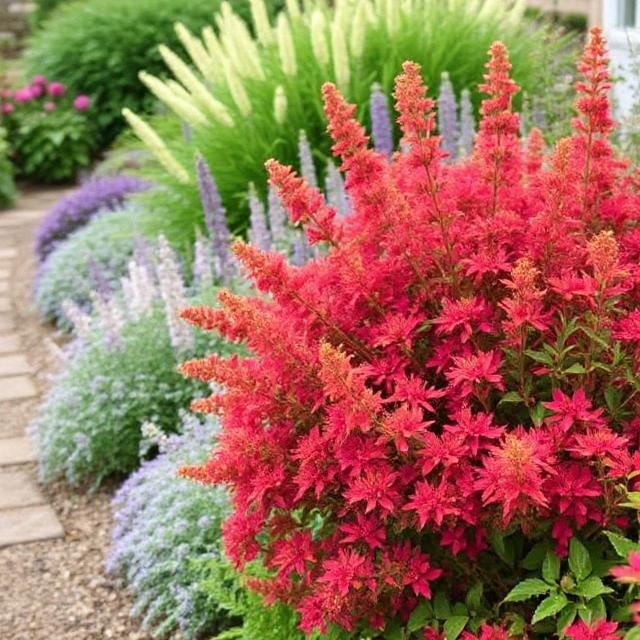
14. Lavender
So, what are the best cottage garden shrubs? Well, shrubs are always effortless care, and I would put lavender relatively high on the list of the best cottage garden shrubs. It won’t grow if you have damp, soggy soil; otherwise, it’s pretty hardy. And by lavender, I mean English lavender. I had great clumps of English lavender which I planted about 12 or 13 years ago – maybe 14 years ago – and it just went on and on and on.
And the bees adored it. We’d see many different kinds of bees and butterflies in the flowers. And then, when the flowers went over, the sparrows would eat the seeds. And then we’d cut it back into neat shapes, which looked good in frost over winter.
15. Roses
Then there are roses. Now, roses are the classic cottage garden shrub. And roses can be high maintenance, depending on what you want to do with them. If you wish to perfect roses with no black spots, you must work hard on it. But if you’re prepared to grow roses amongst many other plants – and growing roses with salvias, for example, can help with black spot – then all roses need is to be given extra fertiliser at the beginning of the year, and in the middle of the year.
They are ravenous plants. But otherwise, many of them are very wildlife-friendly. The very sort of elaborate double blooms are never as good for pollinators as single blooms are. Roses mostly have a gorgeous scent, and what would a cottage garden be without roses?
16. Hydrangeas
Another plant that gives you months and months of interest is hydrangeas. They’re a plant that’s been forgotten about, I think, over the years. There are lots of different kinds of hydrangeas. Some are native to North America, some are native to Europe, some are native to Asia, and you’ll find a hydrangea. Not all of them are wildlife-friendly. The mophead ones are not, because they don’t properly have pollen or nectar.
But the other ones are. And the thing about hydrangeas is that the flowers usually come out in mid or late summer, then they stay, slowly go brown, and become sculptural. And they’re often still flowers, like dried flowers, in winter, and look fabulous in frost. So that’s six months of interest. And hydrangeas are very easy to look after – you have to prune them once a year. I’ve also included a video about how to prune hydrangeas easily in the description below.
Cottage Garden Perennials
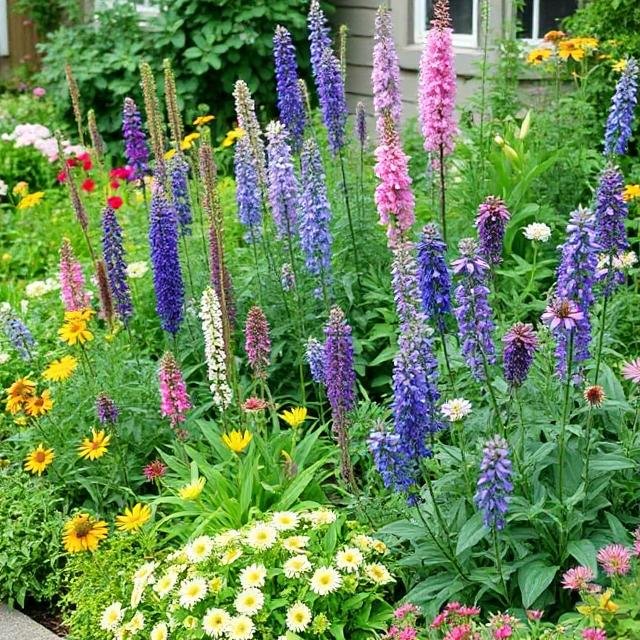
17. Monarda (Bee Balm)
So, cottage garden perennials. Well, perennials are low maintenance because they live in your garden for 3 years or more, and very often all you have to do to them – apart from sometimes deadhead them to have more flowers – is to dig them up about every three or four years, if they’ve grown into a great big clump. You divide the clump and then replant it, giving you plants for free. Monarda, or bee balm, is another straightforward plant. It doesn’t like very wet or boggy conditions; otherwise, it’s resilient. And it’s deer resistant, which is excellent. It’s not particularly slug-resistant – you may get some slug attacks, but usually it won’t stop you growing the flowers.
18. Verbena Bonariensis
Verbena bonariensis has to be the perennial, relatively short-lived perennial that cottage gardens would love. Pollinators love it, birds love the seed heads, and they still look good in winter with a long season of interest. Also, because it has many stems throughout this season, all plants don’t leave your border looking too crowded or blocking other plants.
19. Sedum (Hylotelephium)
And I think if there’s one plant I have seen in garden after garden after garden, that is sedum, now known as hylotelephium or stonecrop. Sedum autumn joy and Sedum matrona are two absolute classics. Once again, adored by pollinators. They’re pretty low-growing – best for the front of the border – but they do flower for quite a long time. And they’re pretty challenging. I mean, I planted one of these in the wrong place about 12 years ago, and it was just too shady, and it never really grew.
But it didn’t die. And when I dug it up and moved it into the sunshine, it became a fabulous flower. Hylotelephium can get nibbled by slugs. It’s got that sort of thick fleshy stems and leaves that slugs love. But actuallyy,y one of mine was nibbled by a slug, and a whole little branch brokoffof,f and I put it in a vase. And when I suddenly remembered it was there about 3 months later, I saw that the stem had grown little roots. So I bunged it in the soil, and it’s pleased to make another plant. And really, you can’t ask for more resilience or easier growth than that.
Annuals and Biennials for Cottage Gardens
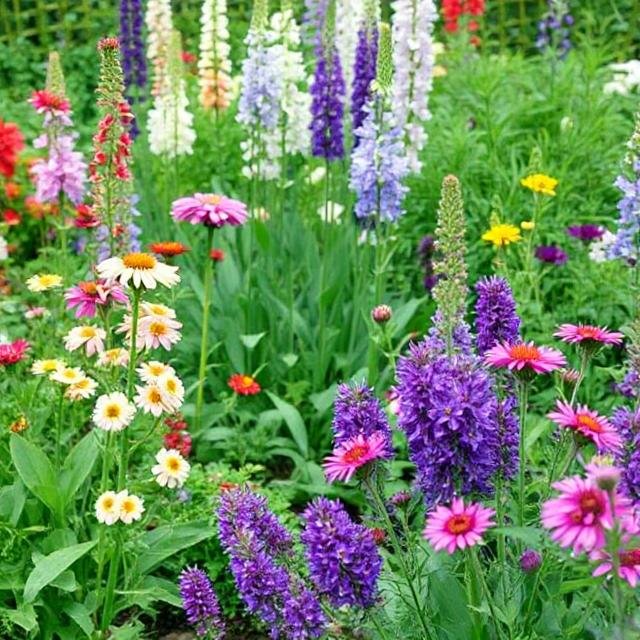
20. Foxgloves
I think every cottage garden needs some annuals and biennials. As annuals are plants that grow from seed,, floer, and die in one year, biennials do it in two. And probably the most famous cottage garden biennial is a foxglove. And foxgloves have these great spires of flowers. Bees once again adore them. They’re very easygoing. I find that foxgloves go where they want to in my garden.
They self-seed, not too vigorously. I have tried planting them in particular places, but they seem to say, “Well, no, we’re going to make up our minds about where we want to grow”. So I pretty much let the foxgloves do what they like. If you cut the first enormous spire off after it’s finished flowering, you’ll get a spray of smaller flowers that can interest you for quite an extended period. Foxgloves are very poisonous, so if you have small children who are likely to try to eat your plants or puppies who try to chew your plants, then don’t grow foxgloves.
21. Hollyhocks
Hollyhocks, another classic cottage garden plant, can be annuals or biennials. And I think a bit like foxgloves, I’ve had people say that they’ve tried to plant hollyhocks in one part of the garden, and it’s been moderately successful. And then a fabulous Hollyhock has sprung up in another part of the garden. But they have that gorgeous floral cottage garden feel to them.
22. Cleome
Another plant that is good for quite a long period is cleome. Now you can get cleomes in violet, pink or white; they grow to be very tall plants. But you don’t have to deadhead them, because they keep getting taller over the summer. Filling a gap with a clump of cleomes will look good, and once again, very pollinator-friendly.
23. Cosmos
And of course, you have to think about the osmosis. Cosmos is a lovely, simple flower, and there are now some lovely new varieties. There’s lemon cosmos. There are frilly cosmoses. Cosmos istraightforwais straightforward. They’re very unfussy. They like a sunny spot, or at least one with partial sun. And they’re just so pretty. And if you keep deadheading them, they will go on and on and on and until the first frosts.
24. Salvias
I looked at a cottage garden in Australia, which the Head Gardener, Bill Bampton, at the Diggers Club said was a cottage garden mashup. So he mixed native plants with typical cottage garden plants to create that same informal, loose, colourful cottage garden look. And one plant that I reckon you could have in any cottage garden, whether a warm-weather or a cool-climate salvia. They’re very long-flowering. We would struggle in the cooler climates, and I struggle to keep my salvias over winter, but that will be fine if you’re in a warmer climate. But salvias are so colourful and long-flowering, it is worth looking at them.
Trees for Cottage Gardens
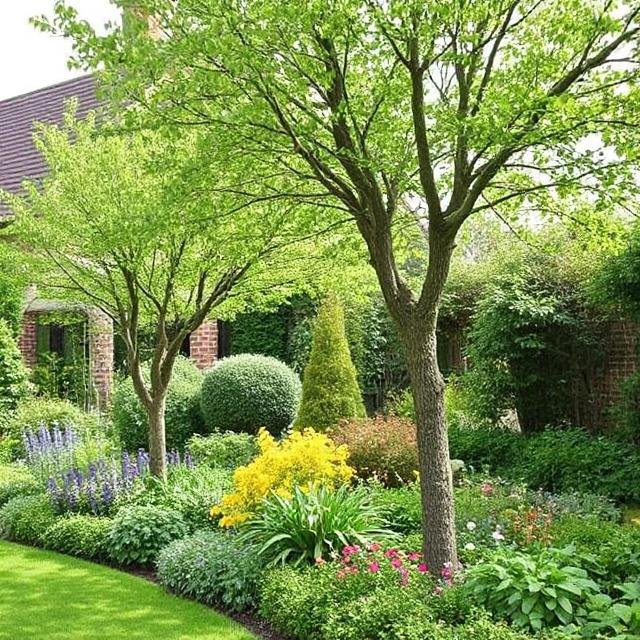
25. Crab Apple Trees
And so what about trees for a cottage garden? Well, you must have a tree. You could grow a climber up it, maybe a honeysuckle, a clematis, but cottage gardens have trees. And of course, above all, they have fruit trees. Or you could have a nut tree or a native tree.
I can’t think of anything better than having a crab apple tree, because there are fabulous flowers in the spring, and then you’ve got the tiny fruit, which you have to make into crab apple jelly. You can’t eat them yourself, and the birds love them. Or you could try a fruit tree that is probably not very well known – something like a quince or a medlar, or even a mulberry or something like that – a fruit tree that perhaps isn’t being grown commercially very widely. Then you can keep it going in your garden.
Conclusion
So, if you want to know more about what cottage garden style actually involves, don’t miss this video, “What is Cottage Garden Style, and how to achieve it?” Thank you for watching. Goodbye!
